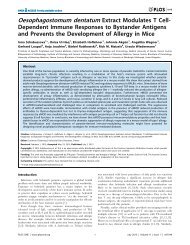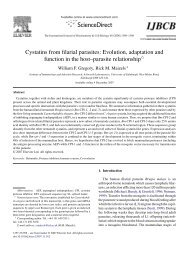Experimental Parasitology - Rick Maizels' Group - University of ...
Experimental Parasitology - Rick Maizels' Group - University of ...
Experimental Parasitology - Rick Maizels' Group - University of ...
Create successful ePaper yourself
Turn your PDF publications into a flip-book with our unique Google optimized e-Paper software.
to Foxp3 effectors has returned to normal. However, Tregs at this stage are more suppressive<br />
on a per-cell basis (Finney, et al., 2007) and play an important role in chronic infection as<br />
inhibition <strong>of</strong> TGF-β signalling, an important factor in the induction <strong>of</strong> regulatory T cells, reduces<br />
adult worm burden and results in an increase in the Th2 response following H. polygyrus<br />
infection (Grainger, et al., 2010). Transfer <strong>of</strong> Tregs (sorted on surface CD25 expression) from H.<br />
polygyrus-infected mice conferred protection from airway allergy to sensitized mice,<br />
reproducing the effects <strong>of</strong> live infection (Wilson, et al., 2005).<br />
The mechanism(s) through which host regulatory cells exert suppression in infected mice<br />
remain to be fully established. Significantly, IL-10 does not appear to be a key player, as airway<br />
allergy can be suppressed by transfer <strong>of</strong> IL-10-deficient cells from infected mice (Wilson, et al.,<br />
2005); experiments in globally IL-10 deficient mice indicated loss <strong>of</strong> protection against allergy<br />
(Kitagaki, et al., 2006), but in these settings there a major changes in baseline inflammatory<br />
levels which complicate interpretation. However, since H. polygyrus can avert colitis in IL-10-<br />
deficient mice (Elliott, et al., 2004), it is clear that the parasite's ability to dampen<br />
immunopathology is not entirely dependent upon this cytokine. In contrast to any suppressive<br />
role, IL-10 may well be acting to promote Th2 immunity, as antigen-specific IL-10 recall<br />
responses track the production <strong>of</strong> the Th2 effector cytokines IL-4, IL-5, IL-9 and IL-13 (Finney, et<br />
al., 2007). IL-4 dependent IL-10 may promote Th2 immunity through specific downregulation <strong>of</strong><br />
Th1 cells, whilst permitting outgrowth <strong>of</strong> Th2 cells, as has previously been demonstrated to<br />
occur in response to N. brasiliensis excretory-secretory (NES) antigens (Balic, et al., 2006).<br />
Another prominent immunoregulatory cytokine is TGF-β (Li, et al., 2006), with particular<br />
significance for H. polygyrus. In chronic infection <strong>of</strong> C57BL/6 mice, plasma TGF-β levels rise<br />
threefold over 30 days, but return to baseline within a week <strong>of</strong> curative drug treatment (Su, et<br />
al., 2005). Interestingly, as discussed below, the parasite produces a functional TGF-β mimic,<br />
which may further increase the high plasma levels during active infection. Although TGF-β-<br />
deficient mice do not survive to adulthood, animals bearing a genetic construct in which T cells<br />
alone express a dominant negative TGF-β receptor (TGF-βRII dn ) are viable. While TGF-βRII dn<br />
mice develop colitis like IL-10-/- animals, infection fails to ameliorate pathology, indicating an<br />
essential function for TGF-β in parasite immunomodulation (Ince, et al., 2009).<br />
Surprisingly in view <strong>of</strong> the indicated role for TGF-β, TGF-βRII dn mice are fully susceptible to H.<br />
polygyrus infection (Ince, et al., 2009); while this result could indicate that TGF-β is not required<br />
for parasite establishment, an alternative interpretation is that the excessively high Th1 bias <strong>of</strong><br />
these mice (as evidenced by up to 25-fold higher IFN-γ levels) prevents a protective Th2<br />
Maizels et al Hydra Special Issue Page 7





